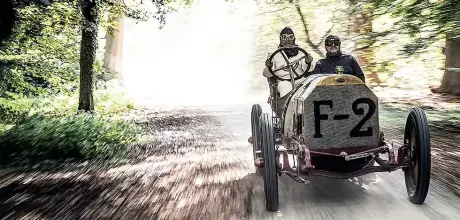1907 Fiat 130HP Corsa
This monstrous Fiat 130HP was driven to victory by Felice Nazzaro in the 1907 French Grand Prix. Massimo Delbò dons his goggles and gathers his courage.
Photography Alessandra Leocata
Only the BRAVE
1907 FIAT 130HP CORSA — MONSTER FIAT 130HP
Braving a 16-litre Grand Prix veteran
In the early 1900s, Fiat cars were a roadgoing status symbol. Their trademarks were state-of-the- art engineering and craftsmanship, and their status was enhanced by success in racing. Today we take the idea that competition improves the breed with a pinch of salt, but back then it was absolutely true, even in that pioneering era. The company – Fabbrica Italiana Automobili Torino – was established in 1899 by incorporating Giovanni Battista Ceirano’s business Accomandita Ceirano. As early as April 1900, its 6HP Corsa (powered by a two-cylinder 1082cc engine) won on its debut in the Torino- Asti race. Three were built for the works team, and the company established its tradition of creating a special vehicle dedicated to racing (hence the ‘Corsa’ name). The car was very good indeed, the creation of gifted engineer Aristide Faccioli, Fiat’s first technical director, who’d had the same role at Accomandita Ceirano (after leaving Fiat in 1901, he fathered the first Italian aeroplane).
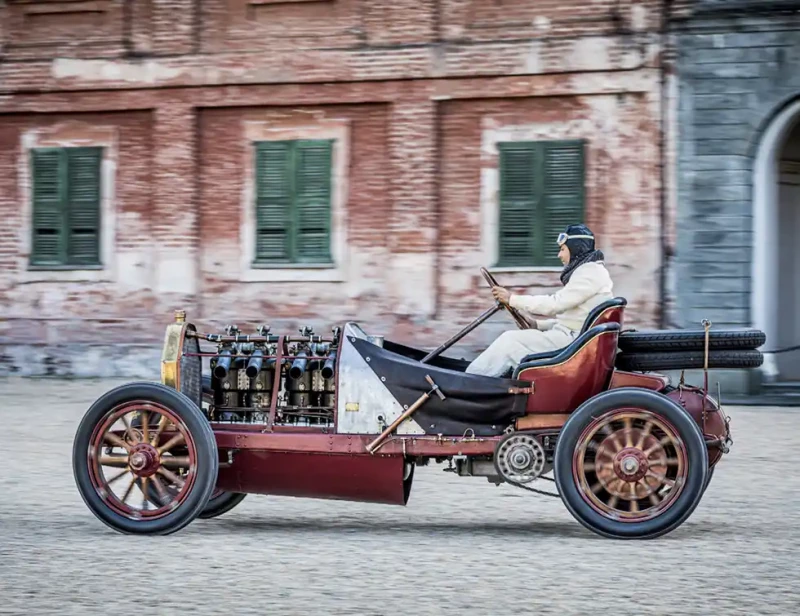
‘THE STEED FOR THE FRENCH GRAND PRIX HAD TO BE REALLY SPECIAL. THE 130HP CORSA WAS THE RESULT’
Faccioli was replaced by Ingegnere Giovanni Enrico, a legendary figure in the engineering of early cars. Born in Casale Monferrato in 1851, he brought to newly established Fiat the technical ability and vision necessary to excel. His first design was the 12HP, an important commercial success for Fiat that featured its first bi-block four-cylinder engine, one of the first ever to be equipped with a honeycomb radiator. Among Enrico’s patents were an automatic retard regulator working with a low-tension magneto and the inclined overhead valves that he would adopt on his 1905 100HP design.
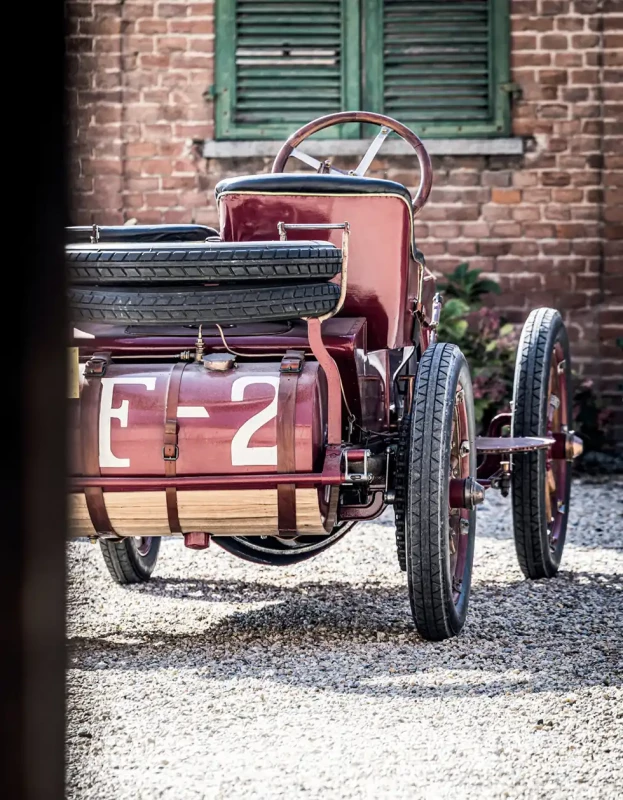
The 12HP Corsa was the second Fiat dedicated to racing and soon established itself as a winner. As for the drivers, both had come from Ceirano: Vincenzo Lancia (later to establish his own car company) and Felice Nazzaro, considered among the best racers of the period.
Nazzaro was born in 1881 near Turin. The son of a humble charcoal merchant, at the age of 17 his passion for mechanical engineering took him to the Ceirano bicycle workshop and then, following the growth of the company, to cars. Branded Welleyes, the Ceirano cars were test-driven by Nazzaro and Lancia, leading to a friendship between the two that lasted their whole lives. With Fiat they began their racing adventure by taking the wheel of the 6HP at the Padua meeting of June 1900.
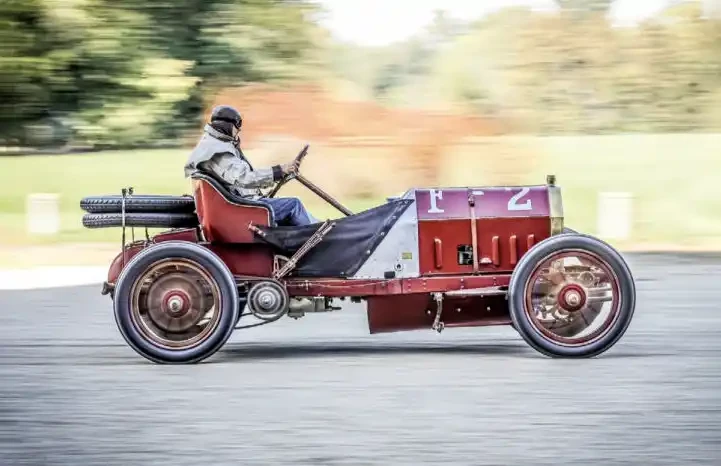
‘NAZZARO’S GOLDEN YEAR WAS 1907, WITH VICTORIES IN ALL THREE INTERNATIONAL EVENTS OF THE SEASON’
The following year, Nazzaro won the two races of the ‘Livorno Summer Celebration of Cars’ in the 12HP Corsa before moving to Palermo in 1902. There he was hired by the Florio brothers to manage their family’s huge garage of touring and racing cars and run them as a nascent scuderia. At the end of 1904, after several successes, Nazzaro was back racing for Fiat, finishing second in the 1905 Gordon Bennett Trophy (the last ever) with the new 110HP Corsa – a bi-block, four-cylinder car of 16,286cc, capable of 110bhp at 1200rpm – which evolved from the 100HP Corsa that was used for other races that year and in which he won the Susa-Moncenisio hill-climb.
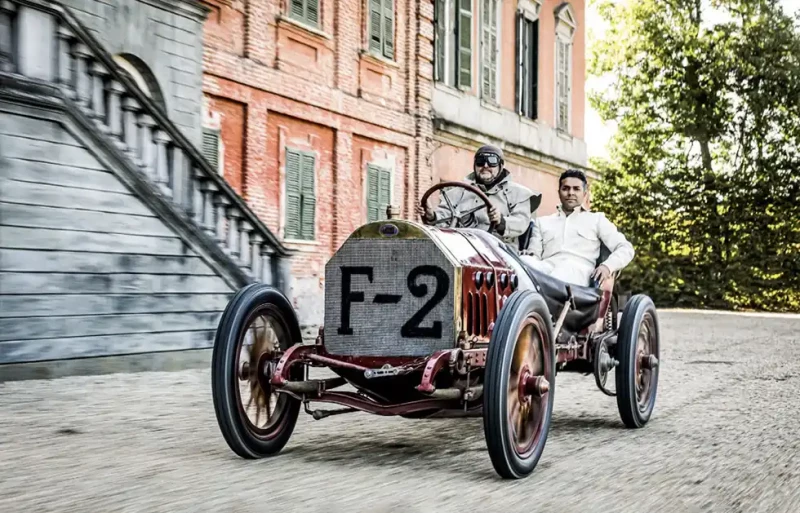
Nazzaro’s style was reported to be ‘refined and not aggressive’ – he was known for his calm temperament and wisdom. In 1906 he finished second at the first Grand Prix de l’Automobile Club de France, which took place on public roads outside the city of Le Mans and was created to replace the Gordon Bennett formula. The race called for about 12 hours of driving over two days, six laps per day for a total distance of 1238km (around 769 miles). The ACF rules imposed a weight limit of 1000kg and fuel consumption of no more than 30 litres per 100km.
Nazzaro’s golden year was 1907, with victories in all three international events of the season: the Targa Florio in Sicily, the Kaiserpreis in Germany’s Taunus mountains, and the Automobile Club de France Grand Prix in Dieppe. Surprisingly, each race had dedicated rules, forcing entrants practically to develop a dedicated car for each one of them. The 28-40HP Targa Florio Corsa featured a bi-block four-cylinder of 7363cc for 60bhp, an 800kg dry weight and a top speed of about 100km/h.
The ‘Taunus’ Corsa’s figures were 8004cc, 72bhp, 950kg and 130km/h. Meanwhile, the steed for the French Grand Prix had to be really special, and the 1907 130HP Corsa, of which three were built, was the result.
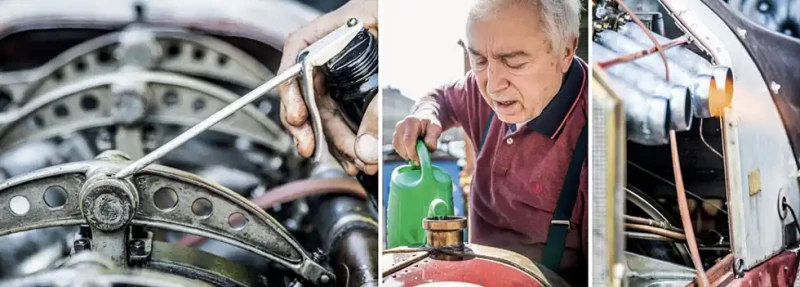
The 130HP was derived from the 1905-06 110HP, and was a real beast with a bi-block four-cylinder engine of 16,286cc and a top speed of 160km/h. On Tuesday 2 July, 37 cars started racing from 6:01am on the 779.9km distance, formed of ten consecutive laps anti-clockwise on a triangular route from Fourche de Neuville in Dieppe to Londini.res, before turning to Eu and then back to Dieppe. The fuel consumption format (30l per 100km) was kept the same as for the 1906 race and strictly enforced, as was the starting interval of 60sec between drivers. Michelin wheels with detachable rims, as seen in the ACF GP of 1906, were made mandatory as Michelin was the main sponsor of the event. The system reduced tyre replacement time from 15 minutes to just four.
Vincenzo Lancia was first to take off, in Fiat 130 number F1, while Felice Nazzaro and his riding mechanic Luigi Fagnano were in car number F2 (start time 6.18am); the Frenchman Louis Wagner was in car number F3 (starting at 6.29am). Both Wagner and Lancia were forced to retire, while Nazzaro won the race, having completed the final 78km lap in 38min 35sec for a total racing time of 6hr 46min 33.2sec at an average speed of 113.6km/h. He beat the Renault of the previous year’s Hungarian winner, Ferenc Szisz, by seven minutes. It was a triumph for Fiat and for Nazzaro, too.

The car you see here is the one driven by Nazzaro. ‘It is still widely stamped on most of its parts with “F2” or with “FN” for Felice Nazzaro, while it has “Fiat 2” on the engine block,’ says Davide Lorenzone, the curator of Mauto, the National Car Musuem of Turin, Italy. ‘It is a miracle that it survives, the only one of the three to do so. We know that it came back to Italy after the 1907 race and remained in Fiat ownership, used in 1908-1909 in several Italian competitions, including the Coppa Florio in Bologna with the other two cars. All three were modified at the rear, including seats and tanks, and were developed to comply with different rules.’
The car went to France in 1910, to Monsieur Auguste Antony, a mechanical engineer who had manufactured engines, bicycles and voiturettes bearing his name in the Douai region. Says Davide: ‘In 1910 he was a Fiat distributor, probably linked with the Paris main dealership Loste, the first Fiat dealership in France, and we believe he received the car as a promotional tool. Antony kept the 130HP until 1955, using it for some time in local events and carrying out modifications, such as a high tension magneto ignition with spark plugs, and installing a Claudel-Hobson carburettor.’
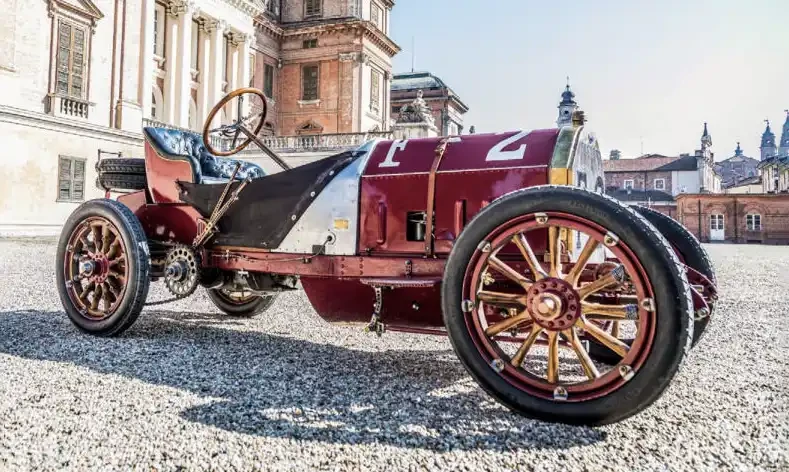
It’s to Antony’s great credit that he saved the car because in the ’20s Fiat crushed all its Corsas (including the other 130HPs) to prevent competitors copying Fiat technology. However, by 1955, when French classic car trader and restorer F Mortarini bought the car, it hadn’t run for 27 years. ‘It had been parked under some trees, in quite dilapidated condition, with a broken radiator and missing its hood and Michelin rims,’ says Davide.
‘Monsieur Mortarini carried out a restoration, of about 1700 hours. Just to open the rusted bolts he had to cover the car in diesel fuel for two months, but, as was typical of the period, without too much respect to originality, he added gold stripes on the body and whitewall tyres.’ Soon after finishing the job, Mortarini offered the car to Carlo Biscaretti di Ruffia, the Turin car museum founder.
The price was too high, but Fiat CEO Vittorio Valletta sponsored the purchase and presented the car to the museum after some aesthetic work, performed by Fiat, to return the car to how it looked at the 1907 Grand Prix de France, replacing the rear fuel tank and retrimming the seats. From then the car was put on static display at the museum except for special occasions.
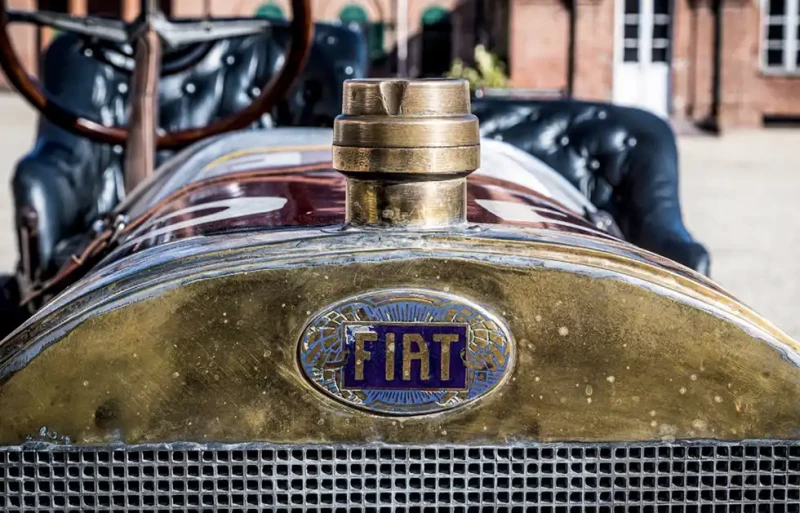
At the end of the 1970s the 130HP was handed to Fiat’s own mechanics’ school, which carried out work on the gearbox and transmission; it ran at the Cicuito del Valentino memorial event in 1984 and 1985 but then remained silent until 1999, when Fiat requested some of the cars from the museum, including the 130HP, for its centenary celebrations.
And then disaster struck. ‘The piston of cylinder number one punched a hole in the block, in the oil sump and in the cylinder wall, and the car was left on static display until 2017,’ says Davide. ‘That’s when I joined the museum, to head the new internal restoration centre and to evaluate the condition of the cars. In 2019, after spending six months studying every possible original technical document, we began the restoration, a process that took three years. We were lucky that the Fiat archive had saved all the original blueprints, so we had every possible piece of information we required.’
As many as possible of the original components were kept, and the task of rebuilding the engine went to Gianni Torelli, the Italian wizard of Edwardian cars, from Campagnola Emilia. Says Davide: ‘Gianni has decades of experience with these kinds of engines, and dismantling the engine together was very instructive as we better understood the extent of the damage. The oil sump was too compromised and needed to be replaced. Luckily the two cylinder blocks were in much better condition, and it has been possible to weld a patch to close the hole in the lower part of cylinder number one. It was a very difficult task, as we needed to recreate for the patch the closestpossible type of cast iron.’
The block was heated before the patch was welded in place, and then came a chemistry lesson. ‘We left everything cooling down for more than 48 hours in a bath of vermiculite, a hydrous phyllosilicate mineral that expands significantly when heated. It allowed the whole structure to cool down in a consistent way, avoiding the risk of new cracks close to the weld,’ says Davide. ‘The valves were damaged, too, so we had to recreate them, as well as the camshaft, conrods and pistons – almost five kilos each! – but we saved everything else. In keeping the original crankshaft, we retained an original mistake that forced us to adjust every conrod neck and forced us to have slight length differences in each conrod,’ he adds. ‘To balance everything, starting from something so uneven, we worked on the new, cast pistons: we kept an excess of material in the inner part and slowly ground away material until we reached an even weight for all four. As for the radiator, we saved the original brass frame, but the internal cooling element needed to be remade, as in period, using about 8300 drawn brass pipes with a 1mm cavity surrounding them. Paired with the vented flywheel, it cools down perfectly, but the car has to be moving!
As with every racing car, standing still is not allowed.’ With a story as long and momentous as this to consider, sitting behind the steering wheel brings with it certain emotions and endless ‘What if?’ questions. Davide, sitting by my side, reassures me with a smile as off we go. The torque delivery of the gargantuan four-cylinder engine is astonishing, literally pulling you away; likewise the rate of acceleration. Every straight becomes too short: first gear is long, and it’s impossible to go beyond third without breaking speed limits. To drive this racing car is to be surrounded by loud explosions and visible flames from the exhausts, and I start wondering how Nazzaro and friends were able to race on primitive road surfaces at such speeds as the official reports show!
The steering wheel rim is rock-hard and transmits every possible lump from the road. Braking is more an idea and a gesture that provide little results in real life, with the car barely slowing down. To slow before a corner, you have to do what the racers of the period did: put the car into a (hopefully) controlled angular slide. This technique is effective on dirt roads but rather difficult on tarmac, so you just have to hope that the visual impression the car makes on other road-users is intimidating enough that they stay out of your way.
The gearbox is easy to manage on instinct: you have to feel the right moment to move the lever, and not do so too quickly, as it enjoys a moment’s pause in neutral before being re-engaged. The engine is very sensitive to the correct positioning of the advance-retard lever on the steering wheel, which the driver has to adjust constantly to obtain smooth passage. When everything is set in the correct way, you get an immediate reward from the Fiat’s muscular burgeoning of pace, but it’s hard work.
Later, taking a well-earned shower, I notice the effects on my dirty face of the exhaust and a light spray of oil emanating from the engine bay and below. While scrubbing my hands, trying to bring them back to their regular colour, I feel my eyes burning: they certainly look quite red in the mirror. How did Nazzaro and his colleagues feel after ten hours of sustained high-speed driving all those years ago? For me, it’s a price worth paying. The 130HP is a highly addictive drug.
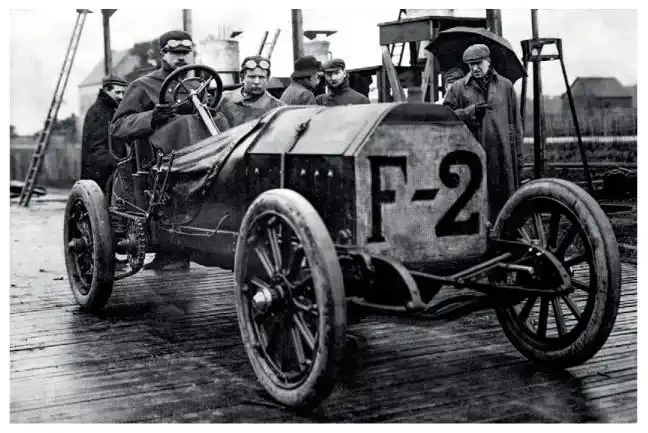
MOTORSPORT IMAGES
TEHNICAL DATA 1907 Fiat 130HP Corsa
- Engine 16,286cc bi-block OHV four-cylinder, Fiat carburettor with pressurised tank
- Max Power 130bhp @ 1600rpm
- Max Torque 100lb ft @ 1000rpm
- Transmission Four-speed manual, rear-wheel drive by chains
- Steering Worm and sector
- Suspension Front and rear: beam axles (live rear), leaf springs, friction dampers
- Brakes Pedal-operated transmission belt, lever-operated rear drums
- Weight 830kg (dry)
- Top speed 100mph
Clockwise, from top of facing page Incredible torque of the 16.3-litre engine means a case of foot down and hang on for dear life; ‘F2’ was Nazzaro’s racing number; brass instrumentation is a work of art in itself.
Clockwise, from this page Ingegnere Giovanni Enrico created the 130HP Corsa specifically to meet French GP requirements; Octane bravely takes a turn at the wheel; racing success and technical innovation made the Fiat name a status symbol in 1907.
Clockwise, from above Felice Nazzaro in the 130HP, on winning the 1907 French Grand Prix; exposed valvegear looks threatening; essential coolant; stub exhausts aflame; scale of bi-block engine is monumental.


